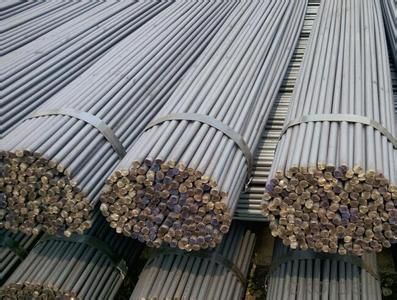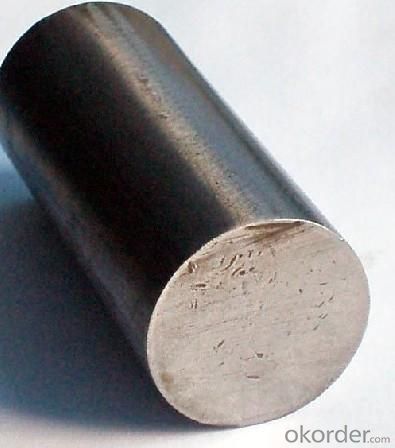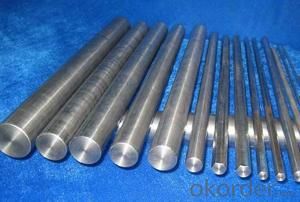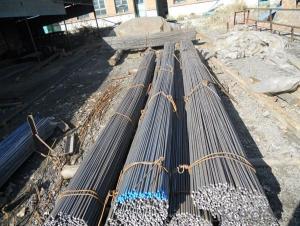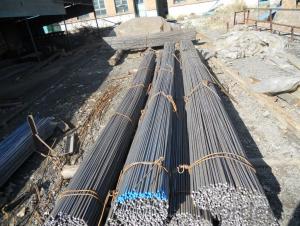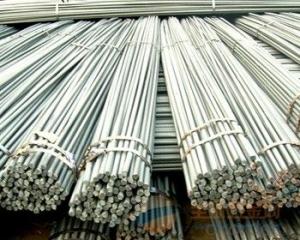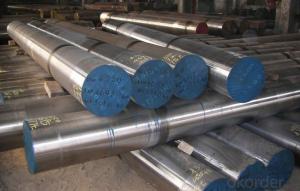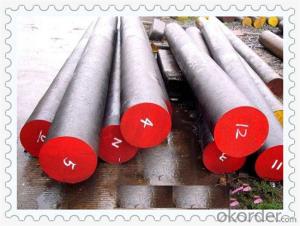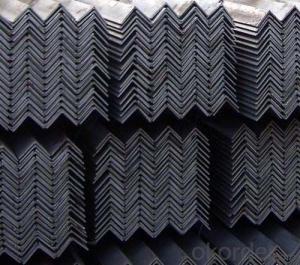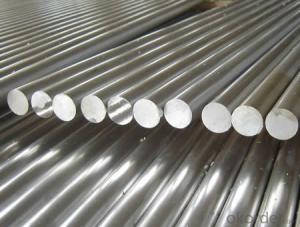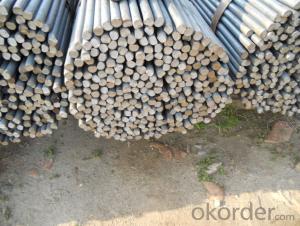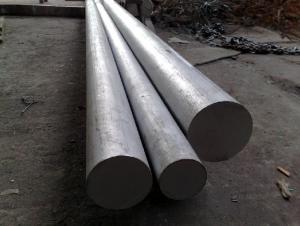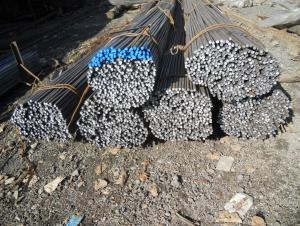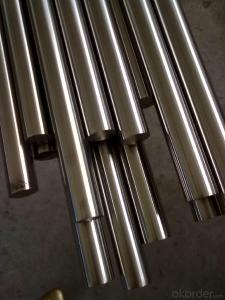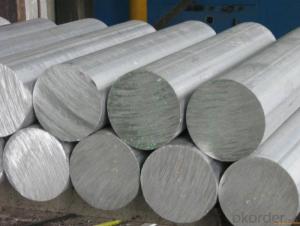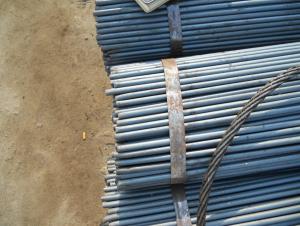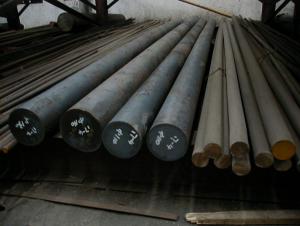Round Bar Hot Rolled High Quality 3MM-25MM
- Loading Port:
- Tianjin
- Payment Terms:
- TT or LC
- Min Order Qty:
- 25 m.t.
- Supply Capability:
- 200000 m.t./month
OKorder Service Pledge
OKorder Financial Service
You Might Also Like
Product Description:
OKorder is offering high quality Hot Rolled Steel I-Beams at great prices with worldwide shipping. Our supplier is a world-class manufacturer of steel, with our products utilized the world over. OKorder annually supplies products to European, North American and Asian markets. We provide quotations within 24 hours of receiving an inquiry and guarantee competitive prices.
Product Applications:
1) Suitable for making various strong cutting tool abrasion resistance, impact resistance.
2) Used to produce all kinds of high hard and super hard saw blade, drill, tap, broach, gear hob and various kinds of milling cutter.
3) Used for advanced punching die, screw die, and the toughness and complicated shape of the punch, etc.
4) Is used for cold forging die and drawing mode, etc.
5) Recommended watchcase factory, screw factory and other cold stamping products industry use.
Product Advantages:
OKorder's Steel I-Beams are durable, strong, and resist corrosion.
Main Product Features:
· Premium quality
· Prompt delivery & seaworthy packing (30 days after receiving deposit)
· Corrosion resistance
· Can be recycled and reused
· Mill test certification
· Professional Service
· Competitive pricing
Product Specifications:
1. Grade: GB, JIS, ASTM, EN
2. Grade: Q235, SS400, A36, S235JR
3. Diameter and mass: As below
Diameter | Mass | Diameter | Mass | Diameter | Mass |
(mm) | (kg/m) | (mm) | (kg/m) | (mm) | (kg/m) |
6 | 0.22 | 22 | 2.98 | 53 | 17.30 |
7 | 0.30 | 24 | 3.55 | 56 | 19.30 |
8 | 0.40 | 25 | 3.85 | 60 | 22.20 |
9 | 0.50 | 26 | 4.17 | 63 | 24.50 |
10 | 0.62 | 28 | 4.83 | 65 | 26.00 |
11 | 0.75 | 30 | 5.55 | 70 | 30.20 |
12 | 0.89 | 32 | 6.31 | 75 | 34.70 |
13 | 1.04 | 34 | 7.13 | 80 | 39.50 |
14 | 1.21 | 36 | 7.99 | 85 | 44.50 |
15 | 1.39 | 38 | 8.90 | 90 | 49.90 |
16 | 1.58 | 40 | 9.86 | 95 | 55.60 |
17 | 1.78 | 42 | 10.90 | 100 | 61.70 |
18 | 2.00 | 45 | 12.50 | 120 | 88.85 |
19 | 2.23 | 48 | 14.20 | 140 | 120.93 |
20 | 2.47 | 50 | 15.40 | 150 | 138.82 |
4. Material: Mild Steel
5. Heat treatment of high quality steel:
Fire: Isothermal annealing temperature is 800 ~ 880 °C, with 10 ~ 20 °C, the furnace cooling to about 600 °C, hardness above HB269.
Preheat temperature: 730-730 °C
Quenching temperature: 1190-1210 °C
Tempering temperature: 540-595 °C
Cold drawn, hardness 285 HBS
Cold drawn after annealing condition, hardness 277 HBS
Quenching methods: oil quenching, air cooling or salt bath quenching
FAQ:
Q1: How do we guarantee the quality of our products?
A1: We have established an advanced quality management system which conducts strict quality tests at every step, from raw materials to the final product. At the same time, we provide extensive follow-up service assurances as required.
Q2: How soon can we receive the product after purchase?
A2: Within three days of placing an order, we will begin production. The specific shipping date is dependent upon international and government factors, but is typically 7 to 10 workdays.
Q3: What makes stainless steel stainless?
A3: Stainless steel must contain at least 10.5 % chromium. It is this element that reacts with the oxygen in the air to form a complex chrome-oxide surface layer that is invisible but strong enough to prevent further oxygen from "staining" (rusting) the surface. Higher levels of chromium and the addition of other alloying elements such as nickel and molybdenum enhance this surface layer and improve the corrosion resistance of the stainless material.
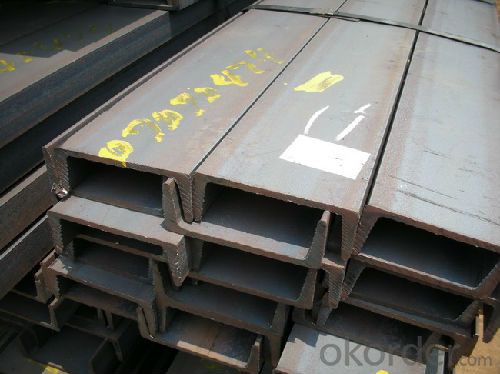
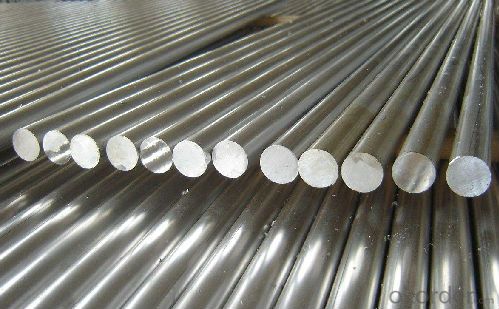
- Q: What are the different heat treatment processes for steel round bars?
- There are several heat treatment processes for steel round bars, including annealing, normalizing, quenching, tempering, and hardening. Annealing involves heating the steel to a specific temperature and then slowly cooling it to relieve internal stresses and improve its machinability. Normalizing is a similar process, but the cooling is done in still air to achieve a more uniform structure. Quenching involves rapidly cooling the steel from a high temperature to increase its hardness, while tempering is a subsequent process that reduces the brittleness caused by quenching through controlled reheating. Hardening is a process that involves heating the steel to a high temperature and then rapidly cooling it to achieve maximum hardness.
- Q: What are the advantages of using free-cutting steel round bars?
- Free-cutting steel round bars boast numerous advantages. Firstly, their impeccable machinability sets them apart. These bars are specifically designed for easy machining, allowing for smooth and efficient cutting, drilling, and shaping processes. This makes them highly suitable for applications that demand precision and intricate detailing, such as the production of automotive components, machinery parts, and precision instruments. Secondly, free-cutting steel round bars offer enhanced productivity and reduced manufacturing costs. Thanks to their superior machinability, these bars significantly reduce the time and effort required for machining, resulting in higher production rates and increased efficiency. Additionally, the reduced wear and tear on cutting tools lengthens their lifespan, thereby reducing tool replacement costs and overall manufacturing expenses. Moreover, free-cutting steel round bars excel in chip control. During machining, the chips produced can impact the final product's surface finish and dimensional accuracy. However, free-cutting steel round bars are specifically formulated to generate small, manageable chips that are easily expelled from the cutting zone. This not only enhances the quality of machined parts but also minimizes the risk of chip clogging or chip-related issues. Another advantage of utilizing free-cutting steel round bars lies in their superb surface finish. These bars are often manufactured with a fine grain structure and minimal impurities, resulting in a smooth and visually appealing surface finish. This becomes particularly crucial for applications where aesthetics and appearance play a significant role, such as in architectural designs or decorative purposes. Lastly, free-cutting steel round bars offer exceptional mechanical properties. They are typically produced with controlled chemical compositions and undergo precise heat treatments, ensuring consistent and reliable mechanical performance. This renders them suitable for demanding applications that necessitate high strength, toughness, and durability. In conclusion, the benefits of employing free-cutting steel round bars encompass exceptional machinability, improved productivity, reduced manufacturing costs, superior chip control, enhanced surface finish, and reliable mechanical properties. These advantages establish free-cutting steel round bars as the preferred choice in various industries and applications.
- Q: Can steel round bars be used for making sculptures?
- Yes, steel round bars can be used for making sculptures. Steel is a versatile and durable material that can be easily shaped and manipulated into various forms, making it suitable for sculpting. The round bars can be welded, bent, or cut to create the desired shapes and structures for the sculpture. Additionally, steel's strength and resistance to corrosion make it a long-lasting choice for outdoor sculptures.
- Q: What are the different heat treatment processes used for steel round bars?
- Some of the different heat treatment processes used for steel round bars include annealing, quenching, tempering, normalizing, and hardening. Each process involves heating and cooling the steel to alter its properties such as hardness, strength, and ductility. Annealing involves heating the steel and slowly cooling it to relieve internal stresses and improve machinability. Quenching involves rapidly cooling the steel to increase its hardness. Tempering is a process that involves reheating the quenched steel to reduce brittleness and improve toughness. Normalizing is similar to annealing but involves air cooling instead of slow cooling. Hardening is a process that involves heating the steel and then rapidly cooling it to increase its hardness and strength.
- Q: How do steel round bars compare to cast iron bars?
- Steel round bars and cast iron bars have several key differences. Firstly, steel round bars are typically stronger and more durable than cast iron bars. Steel has a higher tensile strength and can withstand greater loads and impacts. On the other hand, cast iron bars are more brittle and can break under excessive pressure. Secondly, steel round bars have better corrosion resistance, making them suitable for outdoor or marine applications. Cast iron bars, however, are prone to rusting and require regular maintenance. Lastly, steel round bars offer greater versatility as they can be easily machined, welded, and formed into various shapes. Cast iron bars are more difficult to manipulate and have limited customization options. Overall, steel round bars are generally preferred in industries where strength, durability, and versatility are crucial factors.
- Q: How do steel round bars perform under torsion or twisting forces?
- The exceptional performance of steel round bars in resisting torsion or twisting forces is widely recognized. Thanks to their inherent strength and stiffness, steel round bars can endure high levels of torque without experiencing significant deformation or failure. When subjected to torsion, steel round bars display what is known as elastic behavior. Initially, the bar will twist and deform elastically, meaning it will revert to its original shape once the twisting forces are no longer applied. This elastic deformation is directly proportional to the magnitude of the applied torque, in accordance with Hooke's law. However, if the torsional forces surpass the elastic limit of the steel round bar, it will undergo plastic deformation. This entails the permanent twisting of the bar, preventing it from returning to its original shape after the forces are released. The extent of plastic deformation depends on the magnitude and duration of the torsional forces. The high tensile strength of steel round bars makes them highly resistant to torsional failure, enabling them to withstand substantial twisting forces. Moreover, the round bars' smooth and uniform surface reduces the likelihood of stress concentrations, further enhancing their torsional performance. It is crucial to note that the torsional performance of steel round bars can be influenced by various factors, such as alloy composition, heat treatment, and manufacturing processes. By carefully selecting appropriate steel grades and employing suitable processing techniques, the torsional strength and performance of steel round bars can be further optimized to meet specific application requirements.
- Q: Can steel round bars be used for making conveyor belts?
- No, steel round bars are not suitable for making conveyor belts as they lack the necessary flexibility and surface properties required for effective and efficient conveyor belt operation. Conveyor belts are typically made from materials such as rubber or synthetic fabrics that provide durability, grip, and flexibility to facilitate the movement of goods.
- Q: What are the different specifications for steel round bars?
- The different specifications for steel round bars typically include the diameter, length, and grade of the steel. Other specifications may include the tolerance levels for diameter and length, as well as any specific requirements for surface finish or heat treatment.
- Q: What are the different cutting methods used for steel round bars?
- There are several cutting methods commonly used for steel round bars, including abrasive cutting, cold saw cutting, band saw cutting, and plasma cutting. Each method has its own advantages and suitability depending on factors such as the required precision, speed, and cost-effectiveness of the cutting process.
- Q: Are steel round bars suitable for use in the construction of bridges?
- Yes, steel round bars are suitable for use in the construction of bridges. Steel round bars offer high tensile strength, durability, and flexibility, making them ideal for withstanding heavy loads and structural demands. They also provide excellent resistance to corrosion, ensuring longevity and structural integrity. Additionally, steel round bars can be easily fabricated and installed, making them a cost-effective choice for bridge construction projects.
Send your message to us
Round Bar Hot Rolled High Quality 3MM-25MM
- Loading Port:
- Tianjin
- Payment Terms:
- TT or LC
- Min Order Qty:
- 25 m.t.
- Supply Capability:
- 200000 m.t./month
OKorder Service Pledge
OKorder Financial Service
Similar products
Hot products
Hot Searches
Related keywords



